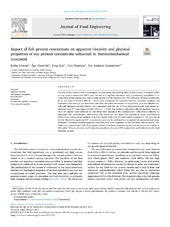| dc.contributor.author | Ahmad, Rafiq | |
| dc.contributor.author | Oterhals, Åge | |
| dc.contributor.author | Xue, Ying | |
| dc.contributor.author | Skodvin, Tore | |
| dc.contributor.author | Samuelsen, Tor Andreas | |
| dc.date.accessioned | 2019-08-20T14:22:50Z | |
| dc.date.available | 2019-08-20T14:22:50Z | |
| dc.date.issued | 2019-04-30 | |
| dc.Published | Ahmad, Oterhals, Xue, Skodvin, Samuelsen. Impact of fish protein concentrate on apparent viscosity and physical properties of soy protein concentrate subjected to thermomechanical treatment. Journal of Food Engineering. 2019 | eng |
| dc.identifier.issn | 0260-8774 | en_US |
| dc.identifier.issn | 1873-5770 | en_US |
| dc.identifier.uri | https://hdl.handle.net/1956/20695 | |
| dc.description.abstract | The aim of this research was to investigate the plasticizing and binding effect of fish protein concentrate (FPC) on soy protein concentrate (SPC) with the use of a capillary rheometer with pre-shearing capabilities. A 3-component mixture design was used to study the effect of the variables SPC, FPC and water. Mixture models with R2 in the range of 0.703–0.998 (P < 0.01) were established for apparent viscosity, extrudate hardness and expansion parameters of the plasticized materials. Extrudate microstructure as porosity, pore size distribution, cell wall thickness and distribution, were measured with the use of X-ray microtomography and models established with R2 in the range of 0.582–0.941 (P < 0.02). The mixture components affected apparent viscosity with the highest value observed for the blend with maximum SPC concentration (1381.6 Pa s) followed by maximum FPC concentration (858.6 Pa s), and lowest for the blend with maximum water concentration (398.0 Pa s). Lowest pellet hardness (136.2 N), density (904.3 kg/m3) and highest expansion (1.44) were found for the blend with maximum SPC concentration and can be attributed to incomplete thermomechanical transformation. Extrudate physical properties and expansion were explained by the extrudate microstructure. FPC added at a concentration of 65–70 g/kg gave values of hardness, extrudate density and microstructure similar to SPC added 100 g/kg of water, confirming the potential for the use of FPC as plasticizer and binder in the fish feed extrusion process. | en_US |
| dc.language.iso | eng | eng |
| dc.publisher | Elsevier | en_US |
| dc.rights | Attribution CC BY | eng |
| dc.rights.uri | http://creativecommons.org/licenses/by/4.0/ | eng |
| dc.title | Impact of fish protein concentrate on apparent viscosity and physical properties of soy protein concentrate subjected to thermomechanical treatment | en_US |
| dc.type | Peer reviewed | |
| dc.type | Journal article | |
| dc.date.updated | 2019-05-29T07:26:09Z | |
| dc.description.version | publishedVersion | en_US |
| dc.rights.holder | Copyright The Author(s) 2019 | en_US |
| dc.identifier.doi | https://doi.org/10.1016/j.jfoodeng.2019.04.014 | |
| dc.identifier.cristin | 1701111 | |
| dc.source.journal | Journal of Food Engineering | |

